Basic Knowledge of an NTC Thermistor
2022-08-24
A thermistor is an electronic component whose resistance changes depending on temperatures. Because measuring a change in its resistance value allows the detection of a temperature, the thermistor can be used as a temperature sensor and is used in many products we find around us. Among various types of thermistors, the NTC thermistor is an element known for its resistance value decreasing with temperature rise. This article will describe this NTC thermistor and its use.
What is an NTC thermistor?
A thermistor is made of semiconductor ceramics whose resistance changes depending on temperatures. Thermistors include a positive temperature coefficient (PTC) thermistor whose resistance increases as temperature increases, and a negative temperature coefficient (NTC) thermistor whose resistance, contrary to the case of the PTC thermistor, decreases as temperature increases. The NTC thermistor is characterized in that, in a wide temperature range including a room's temperature, its resistance changes smoothly in correspondence to temperature change. Because of this characteristic, the NTC thermistor allows the detection of minute temperature differences and is therefore suitable for use in temperature detection and temperature compensation for various electronic devices.
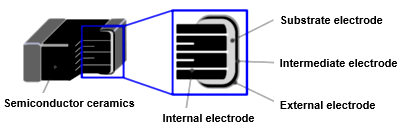
The semiconductor ceramics contain a mixture of oxides; nickel, manganese, cobalt, and iron. A change in a resistance value at both ends of the semiconductor ceramics signals the change in its temperature. This change in the resistance value causes a change in the electric conductivity of the electrolytic solution and in the resistance of electrodes, resulting in a change in the capacitance of the thermistor.
Panasonic's NTC thermistor lineup
Panasonic offers a lineup of NTC thermistors of various sizes ranging from EIA01005 (0.4 mm x 0.2 mm) to EIA0603 (1.6 mm x 0.8 mm). EIA0402 and EIA0603 are for use in vehicles, where the products remain operable under high temperatures of up to 150℃.
Click here to check the products (NTC thermistors).
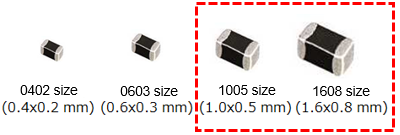
NTC thermistor applications
The NTC thermistor is used for temperature detection in various pieces of equipment you see in your everyday life. It is incorporated in small electronic devices, such as smartphones, digital cameras, and wearable devices, in game machines, mobile batteries, in-vehicle equipment, medical devices, and in household appliances, such as refrigerators, air conditioners, and rice cookers. Let's take a look at some of its uses.
Smartphones/tablets
- Protecting LEDs
LEDs making up camera modules in smartphones and tablets tend to accumulate heat. If the LEDs do not release their heat and remain at a high temperature, they deteriorate faster and their service life ends earlier. The NTC thermistor is used to detect the temperature of the LEDs and, based on the detected temperature, current flow in the LED is limited to suppress heat generation. - Crystal oscillator with a built-in temperature sensor
An element called a crystal oscillator with a built-in thermistor is created by combining a crystal and a thermistor. The thermistor located close to the crystal oscillator detects the temperature and informs an IC of the temperature to make temperature compensation. - Battery
You may notice that your smartphone gradually gets hotter when you keep using it. This happens because of heat generation by the processor and graphic chip plus heat generation by the battery. The battery has a shorter service life when exposed to a high temperature for a long period, but the NTC thermistor helps the battery keep a longer service life. The NTC thermistor detects the temperature of the battery, and when finding the battery temperature high, the system limits current flow in the battery to suppress heat generation.

In-vehicle equipment
Many NTC thermistors are incorporated into different pieces of in-vehicle equipment.
- <Car navigation system>
- ... a thermistor for detecting the temperatures of a power amplifier and liquid crystal display
- <Car air conditioner>
- ... a thermistor for detecting the temperature of the car interior
As in the case of using the thermistor for protecting LEDs of smartphones and tablets, the NTC thermistor is used also in the LED headlights of a car. The NTC thermistor built in the LED headlights keeps the current flow in the LED small when its temperature is high, thus suppressing its heat generation, which is expected to have the effect of extending the service life of the LED.
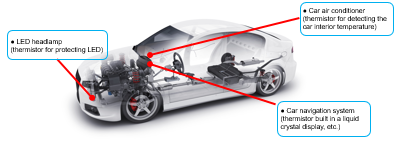
What is Panasonic's high-resistance layer formation technology?
Panasonic manufactures thermistors, using its original technology called "high-resistance layer formation technology." A conventional NTC thermistor has a tendency for its temperature-dependent resistance to change gradually over a long period of service and its temperature detection precision declines as a consequence. The smaller the thermistor is, the sharper the tendency becomes. A thermistor manufactured with the high-resistance layer formation technology, in contrast, hardly shows a change in its resistance and is therefore capable of highly precise temperature detection even after being used over a long period.
Why is the high-resistance layer formation technology advantageous?
Ideally, only the R1 resistance value of an internal electrode should be measured. However, because of the structural features of the thermistor, a resistance measurement includes an R2 resistance value and an R3 resistance value, in addition to the R1 resistance value. When the thermistor is used for a long period, the R2 resistance value and R3 resistance value change under the influence of heat and humidity. As a result, the overall resistance value of the thermistor is given by the following equation.
1 thermistor resistance value = 1 R1 + 1 R2 + 1 R3
Suppressing variations for R2 and R3 is the key to preventing a negative influence on the overall resistance value of the thermistor. A solution to this issue is inserting a high-insulation (high-resistance) layer with large resistance, which makes the R2 resistance value and R3 resistance value larger. The larger the R2 and R3 are, the smaller the 1/R2 and 1/R3 are, that is, the closer the 1/R2 and 1/R3 are to zero, in which case R2 and R3 have little influence on the overall resistance value of the thermistor.
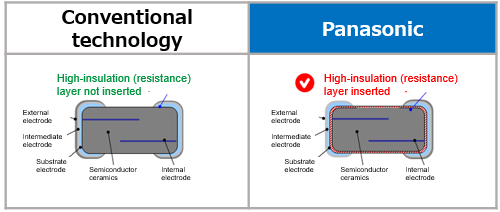
Reliability of the Panasonic NTC thermistor
The Panasonic NTC thermistor containing the high-insulation layer keeps its temperature detection precision almost intact and can detect a temperature precisely even after a long period of service. The following graph (Fig. 6) shows the results of a humidity resistance test conducted on the EIA0603, and it demonstrates that a shift in the resistance change rate of the thermistor is suppressed over a long period of service.
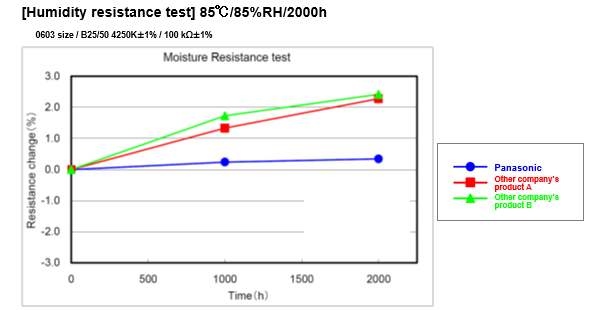
Usually, a smaller thermistor tends to show a larger resistance change rate. This, however, does not apply to the Panasonic NTC thermistor.
Conclusion
The NTC thermistor, which is a temperature sensor, is used in a lot of the equipment we find around us. The key to selecting a better NTC thermistor is to see "whether it remains capable of highly precise temperature detection after being used for a long period." If you are thinking of replacing your thermistor with, for example, a smaller one, please contact Panasonic to let us know the product number of the thermistor you are using. We will offer you a proposal for miniaturization and cost reduction and tell you the product number of a recommended product.
Related product information
Tags related to this article


